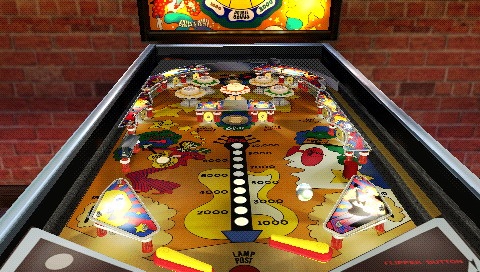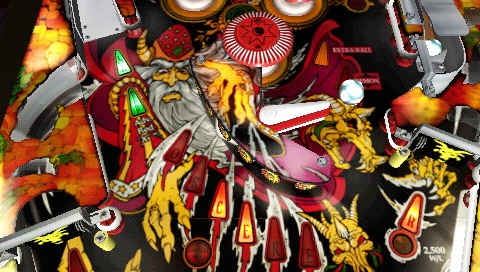The glory days of pinball are back, at least according to the packaging for Pinball Hall of Fame: The Williams Collection. That's not true, no matter how much we'd like it to be, but there's no denying that this collection of 10 tables has plenty to offer for anyone with a penchant for pinball. Not all of the featured tables can be considered classics, but if the lineup was chosen specifically to offer plenty of variety, then it's most definitely a success. Older tables like 1970's Jive Time bear little resemblance to the likes of Whirlwind and Funhouse that were released 20 years later, and playing through this collection in chronological order is a fun way to see how Williams' offerings evolved during that time.

The moment you step into the virtual arcade that serves as the game's menu system, it's clear that The Williams Collection's goal is to re-create as accurately as possible the experience of visiting an arcade to play pinball. You can choose to practice on tables in a mode that awards you tokens based on your scores and the completion of table-specific goals; you can play against up to three friends in tournaments that span multiple tables; or you can take on the time-consuming Williams Challenge. The challenge mode tasks you with achieving target scores on all 10 tables one after another. You get three attempts at each table, and if you fail you have to go back to the first table again. The scores aren't tough to beat once you learn your way around the tables, which is just as well given that your reward for completing the mode is disappointing to say the least. What do you get? You get a score that you can tell your friends about, and a ranking based on how much you beat the target scores by. Being told that you're a "Tommy wannabe" is a nice reference to The Who's dark, pinball-themed rock opera, but it really isn't what you want to hear after taking the time to achieve high scores on 10 tables.
Regardless of which table you're playing, you'll find that Pinball Hall of Fame's controls are flawless--at least when you're holding the PSP the traditional way. The shoulder buttons are perfectly positioned for their role of triggering the left and right flippers, and the analog stick is great for launching balls and for tilting the table. The flippers on these tables never feel unresponsive or sticky, as their real-life counterparts sometimes do, but realism is definitely the name of the game and the all-important ball physics are nigh on perfect. Furthermore, the tables' various targets, bumpers, slingshots, switches, and ramps are every bit as believable as the ball that you're trying to hit them with, which ultimately makes The Williams Collection's gameplay difficult to fault.
If you feel the need to, you can easily change the camera angle using the face buttons while you're playing. Cameras can be problematic in pinball games, but the dynamic camera used here masterfully displays the whole table and zooms in on areas when it's appropriate to do so. Other camera modes include one with a static option that always shows the entire table and another that lets you play while holding the PSP at a 90-degree angle to make better use of the handheld's screen. Playing this way affords you a better view of the action at the top of the table, but the face buttons are a little awkward to use for the flippers, and reaching the analog stick, which still launches balls and tilts tables, is something that only a contortionist should attempt. We can't say enough about how intelligently and smoothly the default camera does its thing, though an option to play from a traditional top-down perspective that showcased the tables' artwork would have been a welcome addition.
Like the home console versions of the game, The Williams Collection on the PSP supports up to four players who must take turns. Unlike other versions, the PSP game also supports simultaneous wireless play for two, and you need only a single copy of the game to take advantage of it. All 10 tables can be shared with another player using a second PSP, but only one at a time. After sharing your chosen table, the pair of you then have the option to do your own thing or to go head-to-head so that you can see each other's scores while playing. Simultaneous play is a lot more fun than passing the PSP around and having to wait for your turn, and sharing tables is quick and painless.
All of the tables in Pinball Hall of Fame look and sound authentic, right down to the labels detailing how much it costs to play and how many balls you get for a single credit, and the loud knocking sound when you earn an extra ball. It's not always easy to see where some of the table features are because the artwork on raised areas blends in with that on the playfield, but these rare moments of confusion aren't detrimental to gameplay since they invariably occur at the top of the table where you don't have to worry about losing a ball.
Pinball Hall of Fame: The Williams Collection doesn't have a lot of competition, so saying that it's the best pinball game currently available for the PSP wouldn't count for much. With its great selection of tables and believable physics this is one of the better pinball games to be released for any platform in recent memory, though, and it's a lot more affordable than a pinball table to boot.
